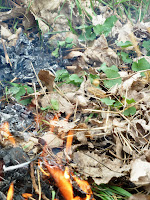 |
Sunset marked the end of the burn day and
graced us with a beautiful view of the Saint Paul skyline |
The burn season is upon us. Prescribed burns, also called controlled burns, are an important management tool used by natural resource professionals. Fire can be intimidating, but when used properly the benefits are undeniable.
 |
Protecting young trees
as the fire passes |
Why are controlled burns used in Saint Paul's parks? As with most natural areas, the presence of undesirable plants such as invasive species and turf grass in Saint Paul's parks is unavoidable. However, with management techniques such as prescribed burning, we can keep the extent of their presence under control. Many undesirable species are 'cold season' plants. This means that they are able to leaf out earlier in the spring while soil temperatures are still fairly low. That ability gives these unwelcome plants a head start on the growing season and puts native 'warm season' plants in a tough spot. Once the growing conditions are suitable for native plants, the weedy species are already thriving. This leaves native plants struggling to get the sunshine, water and nutrients that they need to be healthy.
 |
A patch of garlic mustard
about to be consumed by flames |
How does fire help? There is a short window of time during which many of the weeds and invasive species have already sent much of their energy from their roots to their leaves, stalks, and buds above ground. This is when they are most vulnerable. Meanwhile, native plants are still dormant--retaining their energy below ground, waiting for soil temperatures to warm up enough for them to begin growing. Using prescribed fire as a management tool allows land managers to knock back undesirable plants that have emerged from the ground after they have expended much of their energy reserves. Simultaneously, the newly exposed soil can absorb the sun's energy--warming the soil, kick starting and extending the growing season for warm season, native plants. Win-win!
Want to know more? Check out
this description on prescribed fire from the Minnesota Department of Natural Resources. Go for a visit or check back on the blog for photos of
Bruce Vento Nature Sanctuary plant life emerging from the ashes in the next few weeks!



